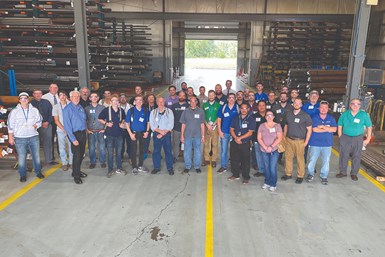What Attendees Experienced on PMPA’s Mastery Program
The PMPA recently hosted its new Mastery Program. The first of three tours was held in Cleveland, Ohio. Where did attendees go and how did they broaden their knowledge?

The Mastery Program at Northlake Steel in Valley View, Ohio.
The PMPA recently hosted the first of three Mastery Tours, in association with our National Technical Conference and PMTS show in Cleveland, Ohio. Performers from operations, purchasing, engineering and management saw for themselves the supply chain that serves them in order to broaden their knowledge.
The attendees received reference materials produced to give them deeper insights into the materials and processes used by their suppliers.
First, due to COVID-19 restrictions, attendees were unable to visit Charter Steel, but were shown two videos describing the full process of melting, casting and rolling Special Bar Quality Steel (SBQ) at Charter Steel.
The impact of seeing how the process starts with huge quantities of carefully selected scrap and other materials, the various computer controls, and processes to not only melt but refine and customize the material to make an optimum product changed a lot of minds regarding raw materials versus “precision inputs.”
Then, our mastery program attendees were guided through the PMTS exhibits, visiting approximately 80 PMPA member booths where they were given an overview of why the technology displayed might or might not be important in their shop.
Several attendees remarked that they would not have stopped at that booth and were glad they did because they didn’t realize how it related to their shop.
Experiencing First-Hand
Toolmakers work to tolerances often one-tenth as “generous” as ours. Our attendees’ first visit was to Fisher Special Tooling in Mentor, Ohio, where they saw the best practices and technologies used to create the “special” tools used in our shops. Some attendees had no idea that custom tooling was even an option. Others learned how the tolerances are achieved, and all gained interesting insights into how 5S — as deployed at Fisher — was a production advantage.
PMPA’s Mastery Program consists of three, two-day bus tours for participants to see the precision machining supply chain; two valuable reference books; and instruction from industry expert Miles Free III.
Machine importers are just something that we take for granted. At Absolute Machine Tools in Lorain, Ohio, attendees walked through the entire process of importing the machine tools that are found in our shops. Handling payment details, shipping and freight forwarding, customs details and inventory storage helped our attendees get a much richer picture of the investment involved — and the global reach and expertise needed — in acquiring the machine tools on which they exercise their craft.
Concast Metal Products in Birmingham, Ohio, gave our attendees the chance to see the actual production of continuous cast bronze and copper alloys — from batching of the materials for the initial melt, through casting, laboratory testing and analysis, and mark, pack and load. This gave our attendees a further appreciation for how their workpieces are produced — and what that means for performance on their machines.
Northlake Steel in Valley View, Ohio, was the last stop and the goal was to see not just the range of cold finishing processes but the understanding of how those processes imparted properties into the starting hot-rolled steel. Turning processes for turned and polished, shot-blasting ahead of cold drawing and straightening to remove the hard abrasive oxide scale that would destroy tool edges in our machines were just two of the many things attendees experienced. Straightness is critical in shops, so seeing the processes for Medart and press straightening at Northlake gave attendees a better understanding of what is happening upstream of their machines — and why careful handling to preserve straightness is crucial. One attendee told us, after seeing the centerless grinding operation, “Now I know why centerless ground bars cost so much and why they are worth it.”
Related Content
Onshoring Weather Report: Strong Tailwinds!
Onshoring, reshoring, nearshoring: these terms are showing up with increasing frequency in the news and online. But is there evidence that these are real?
Read MorePrecision Ground Barstock: How It Is Manufactured, Benefits to Your Shop
Understanding the benefits provided by precision centerless ground barstock can help you avoid false economy and optimize the work you quote by maximizing benefits to your manufacturing process and customer.
Read MoreCraftsman Cribsheet No. 128: Why Do Machinists Say Tenths Instead of Ten Thousandths?
In machinist parlance, a tenth is a tenth of a thousandth, not a tenth of an inch.
Read MoreCraftsman Cribsheet No. 121: ISO Turning — What Does it All Mean?
How to make sense of all those different letters and numbers in ISO turning inserts.
Read MoreRead Next
A Tooling Workshop Worth a Visit
Marubeni Citizen-Cincom’s tooling and accessory workshop offers a chance to learn more about ancillary devices that can boost machining efficiency and capability.
Read More5 Aspects of PMTS I Appreciate
The three-day edition of the 2025 Precision Machining Technology Show kicks off at the start of April. I’ll be there, and here are some reasons why.
Read MoreDo You Have Single Points of Failure?
Plans need to be in place before a catastrophic event occurs.
Read More











.jpg;maxWidth=300;quality=90)









